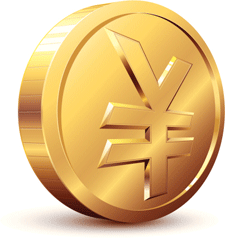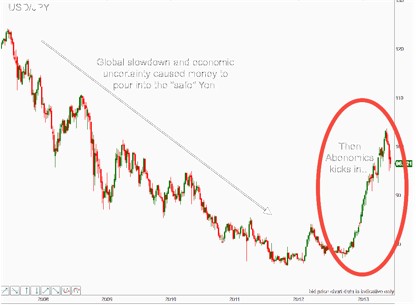 Last week I said that the Yen would be the hot story this week – and it’s been anything but boring.
Last week I said that the Yen would be the hot story this week – and it’s been anything but boring.
The Japanese Yen has been a huge money-spinner for traders in recent years, and there’s every reason to believe it’ll continue to be so… As long as you’re on the right side.
But the movements in the Yen have very little to do with the intrinsic value of the currency – and this is one place where technical analysis alone just can’t cut it. The Yen is at the heart of the currency wars, and you shouldn’t touch this market without having some understanding of what’s going on behind the scenes…
It’s a drama involving trade wars… girl bands… and bras. (Yes, bras.)
Abenomics: a crash course
Abenomics is the name given to the fiscal measures introduced by Japanese Prime Minister Shinzo Abe at the end of last year. Abe’s mission was to kick-start the Japanese economy, which had been in the doldrums for the past decade.
Abe’s plan includes huge fiscal stimulus and monetary easing, including a target to raise inflation to 2% (more on that 2% increase in a moment).
What’s wrong with low inflation? I thought inflation was bad?
Most people would agree that inflation needs to be kept under control. If it gets too high, then it undermines confidence in the economy, and we end up having to use a wheelbarrow instead of a wallet to carry our money around in. But Japan has the opposite problem – inflation that’s too low.
In fact, Japan has been battling with deflation (falling prices) for the past decade. While deflation may sound like a great thing to bargain hunters, and to the huge and growing elderly population in Japan who live off fixed incomes, it’s got some very nasty side effects:
- In general, consumers tend to put off purchases, in the hope that they can get a better deal at a later date.
- Deflation eats into house prices.
- Deflation increases the costs for companies wanting to take on credit, and makes it very difficult for big companies to outgrow their existing debts.
So, some nice, steady inflation (not too high, not too low) gets people spending, and businesses investing.
Shinzo Abe has decided that 2% is the magic number, and his policy has even inspired its own bra (George Osborne must be green with envy) – Triumph’s Branomics, which comes with extra padding for a 2% increase in volume!
So, what’s that got to do with the price of the Yen?
One of the key reasons that Japan wants to get its people spending is because the rest of the world just isn’t buying Japanese exports like it used to.
The global slow-down, increased competition from South Korea, China and Germany, and the expensive Yen have put the brakes on Japanese exports. So, if Japan can get the Japanese spending money, it’ll go some way to balancing the decline in foreign sales.
But, even with the printing presses running overtime, churning out more Yen, there’s only so much money the Japanese can spend…
So, to stay competitive against South Korean electronics manufacturers and German car builders, Japan also needs to do something about the Yen.
Since the 2007/08 financial crisis money has been pouring into the relatively safe Japanese Yen. The result has been a surge in the value of the currency against the dollar.
A strong currency makes your exports expensive to other countries. It’s one of the nasty side effects of a booming economy. But when your currency strength has nothing to do with economic strength, as in Japan’s case, it just seems unfair.
And it’s this unfairness that Abenomics set out to address…

Since Abenomics kicked in, the Yen lost a staggering 25% of its value. This will have direct implications on Korean and German manufacturers – and the feeling amongst some is that Abe has gone too far, too fast.
Notice that sharp fall at the end of the chart? That’s the value of the Yen on the rise again, as fear has come into the equities market.
So what’s going wrong for Abenomics?
Abenomics has a catchy name, and a lot of supporters. It even has its own poster girls: the Japanese girl group Machikado Keiki Japan.
They promised earlier this year to shorten their skirts every time the stock market made significant gains. And their debut single, Abeno Mix (get it?) is a high-brow analysis of quantitative easing and the bond market (so I’m told).
Move over Merle Hazard – I have a new favourite economics-based music act.
However, not everyone is a fan of Abenomics. And many believe that he’s simply trying to swim upstream.
The Japanese have been printing money and racking up debt for years, and it’s never worked before. Sure, this time they made a very convincing stab at it – but are we now seeing the big correction?
Which way’s the Yen going?
The last time I wrote about the Yen (a few months back), it had recently breached the 90 level, and I was doubtful whether the dollar could gain further strength against it. However (serves me right for making predictions!) it forged on up through 100 Yen to the dollar.
But in the last three weeks, the cracks have been showing… This week, investors were hoping that the Bank of Japan would ramp up its stimulus, and disappointment that they’ve stuck to their guns caused a pull back on the chart.
The situation was exacerbated yesterday, when the Nikkei took a sharp decline. The Japanese index has lost a staggering 20% of its value since this year’s high, which was only set three weeks ago. Bad news for fans of short skirts.
The result was the Yen crashing through the key 95 level.
At the beginning of the week, the Bank of Japan didn’t want to look like they’re being forced to up their game, running scared of the massive volatility Abenomics is causing on the Yen, the stock market, and the bond market. They were trying to keep their cool.
However, the situation now looks dire, and unless Abe wants to admit defeat, he’ll have to roll out more stimulus. The only question is ‘how’ and ‘when’.
We can sit around arguing about whether monetary stimulus really helps economies in the long term… but the fact that matters to us immediately as traders is that when a news release announces or hints at more stimulus, the value of the Yen will fall.
Personally, I’m doubtful whether Abe can really continue to drive the Yen downwards in the long-term. Sure, Abenomics worked while the S&P was booming and everyone wanted into the equities market. But at the first whiff of trouble, the Yen comes under pressure again.
But I’d be an idiot to sniff at a policy that affected a 25% change in the value of a currency.
So we can expect continued volatility in the yen – which means some fabulous market moves that traders can take advantage of. However, be very careful around economic and political announcements – in fact, don’t go near this currency during data releases unless you have seriously deep pockets.
